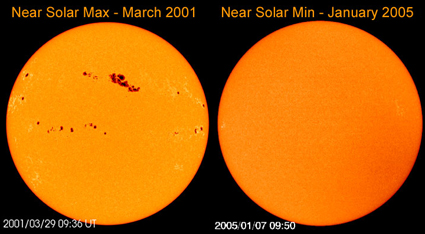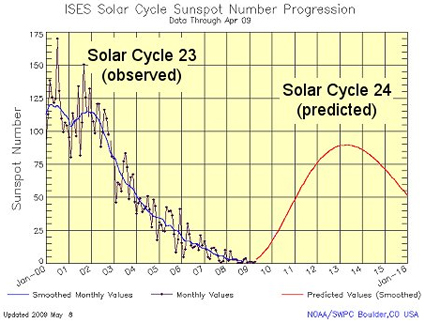What is a solar cycle? Glad you asked. Also known as the solar magnetic activity cycle, it’s a cycle that regulates activities and structures on the Sun. Astronomers measure solar cycles by documenting the number of sunspots on the surface of the Sun. It’s an advanced system. Counting black dots on the Sun. And to make it more exact, the number of sunspots is not constant. They come and go. When they are at their peak, it’s known as the solar maximum; at their low point, it’s the solar minimum. Now even I can understand that type of astronomy.

Perhaps the best definition of a solar cycle is the one I found on Wikipedia:
The Sun’s magnetic field structures its atmosphere and outer layers all the way through the corona and into the solar wind. Its spatiotemporal variations lead to a host of phenomena collectively known as solar activity. All of solar activity is strongly modulated by the solar magnetic cycle, since the latter serves as the energy source and dynamical engine for the former.
I hope that was clear. In the end, the solar cycle is an incredibly important piece of our Sun’s ability to provide us with balanced sunlight and energy. In fact, there are some scientists who believe that our health is related to solar and lunar rhythms (the field is called Chronobiology). As crazy as it sounds, it really seems like the solar cycle may have an impact on our health. And there’s even more – the sun cycle may even effect such things as the prices of goods. I think that has something to do with less/more sunlight causing certain things to happen, particularly in agriculture. But I could be wrong. I’m just saying is all.

This is the reason I am writing this post. A bunch of really smart solar cycle experts have predicted that Solar Cycle 24 will peak in 2013, but it will be the lowest solar cycle since Solar Cycle 16 peaked in 1928 with 78 sun spots. Sun spots are areas of extreme magnetic activity on the Sun’s surface, and they can sometimes be seen from Earth without the use of a telescope. Sunspots look like dark spots on the Sun’s surface, and there are references to sunspots made by Chinese astronomers in 28 BC. Yep, people have been seeing black spots on the Sun for quite some time now. But why does any of this matter?
Solar cycles are capable of producing severe space weather. On September 1, 1859, a British astronomer named Richard Carrington observed the largest solar flare in solar storm that came to be known as the Solar Superstorm of 1859 or the Carrington Event. The Carrington Event caused fires in telegraph offices after it electrified transmission cables. It also produced extremely bright Northern Lights. So bright, in fact, that gold miners in the Rocky Mountains woke up and began preparing breakfast because they thought it was morning. If a similar storm were to happen today, the National Academy of Science estimates the damages could be in the range of $1-$2 trillion. The storm in 1859 caused outages in telegraph systems for most of America and Europe. You can only imagine what a solar storm of that magnitude would do to our communcations systems today. Let’s just say that your Twitter and Facebook accounts would not be updated for a while.

The reason that all of this is important today is because the predictions for Solar Cycle 24 (our current solar cycle) are expected to be the lowest since 1928. Both of these solar cycles are on par to be very similar to the solar cycle during the time of the Carrington Event. “Uh oh,” said Doom & Gloom Guy. But don’t worry too much. The Sun is acting very strange right now. No one can seem to figure out if the solar minimum was in 2008 or if it’s occuring right now in 2009. They thought the solar minimum would be over in 2007, but the were wrong. Very wrong. Also, did you notice the time range labeled Maunder Minimum in the graph? That is an unexplainable 70-year span of spotlessness. It confuses scientists and astronomers to this day.
Right now, we are in an extended solar minimum. And that is good because as noted on NASA’s website (here):
Low solar activity has a profound effect on Earth’s atmosphere, allowing it to cool and contract. Space junk accumulates in Earth orbit because there is less aerodynamic drag. The becalmed solar wind whips up fewer magnetic storms around Earth’s poles. Cosmic rays that are normally pushed back by solar wind instead intrude on the near-Earth environment. There are other side-effects, too, that can be studied only so long as the sun remains quiet.
Enjoy it while it lasts. 2013 could be a scorcher.